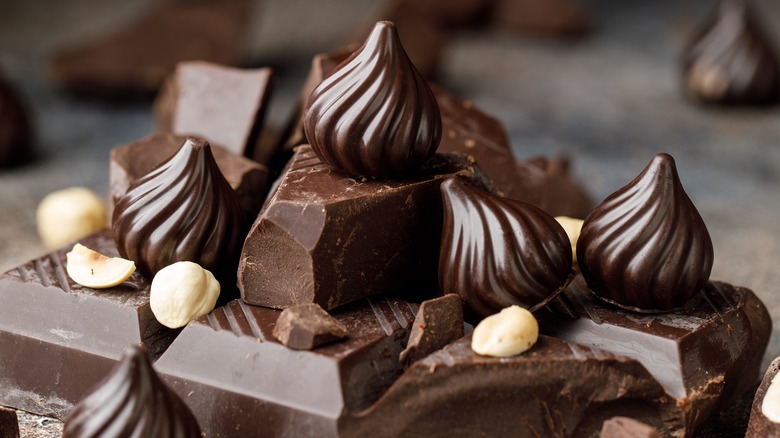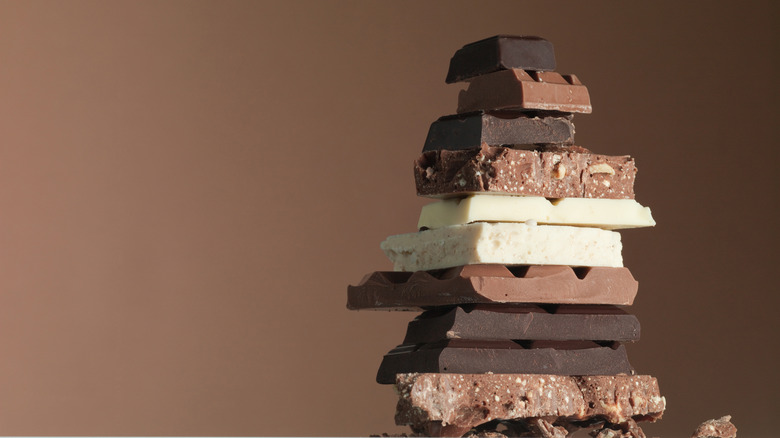What's The Difference Between Baking Chocolate And Chocolate Chips?
Whether your tastes run more towards sweet milk chocolate or you prefer dark chocolate with its bitter edge, one thing almost everyone can agree on is that chocolate is delicious. It gives us a warm fuzzy feeling unlike any other snack. And when we're craving it, nothing else comes close to satisfying that feeling. And in the winter months, there are actually some health benefits of drinking hot chocolate, per the National Library of Medicine.
Even for chocolate lovers, though, the majority of chocolate on grocers' shelves can present a problem in the kitchen. So, how do you choose what chocolate to buy for your recipes? Which chocolates can you substitute for which, and how will it affect a dish?
Baking chocolate and chocolate chips are the two most commonly found chocolates in American kitchens (per Food Network). But not all chocolates are created equal, and these two forms of chocolate will render different results in your baked goods.
How do baking chocolate and chocolate chips differ?
For true chocolate lovers, baking chocolate is the ultimate thrill. According to the Confectionary Foundation, in its unsweetened form, it is entirely pure and unadulterated in any way. Chocolatiers create it by roasting, shelling, and grinding cocoa beans. The resulting slurry, often called chocolate liquor or chocolate mass, is then pressed into blocks. This results in a very bitter and brittle slab of chocolate. Baking chocolate contains 51 to 53% cocoa butter, and this high-fat content makes it so hard. The complete lack of sugar or other sweet compounds accounts for its bitterness.
Chocolate chips are a little more complicated. They come in a wide variety of flavor profiles, depending on their exact formulation. Common chocolate chip offerings include semi-sweet, bittersweet, dark, and milk chocolate chips.
The ingredients most of these chips have in common are chocolate mass, sugar, vanilla, and some type of stabilizers and emulsifiers, per the Fine Chocolate Industry Association. The chemicals make it possible for chocolate chips to hold their shape, even after baking. Unfortunately, they also compromise the natural flavor of the cocoa.
Cooking with chocolate chips versus baking chocolate
Which style of chocolate will work best for you depends on what you're making (and possibly your health goals). The Cleveland Clinic explains that if you're using chocolate to boost your antioxidant intake, then you want to use the product with the highest cocoa content. Because baking chocolate is pure chocolate liquor, it is the obvious choice, while milk chocolate, with only 10-12% cocoa, is the least desirable.
If you simply want to create stunning dishes, there are a few other factors to consider. Chocolate chips keep their shape because of the emulsifiers they contain, per King Arthur Baking. For baked goods, this means that when you use them in classic recipes for Toll House cookies, brownies, or other baked goods, they will maintain their shapes and not run or spread out as much as baking chocolate would.
On the other hand, if you're going to be melting chocolate as a topping, using chocolate chips can be problematic. Because of the emulsifiers, they are harder to melt. In contrast, baking chocolate melts smooth and flows more easily. This makes it possible to create wonderful drizzle effects and creamy pools of chocolate goodness.


